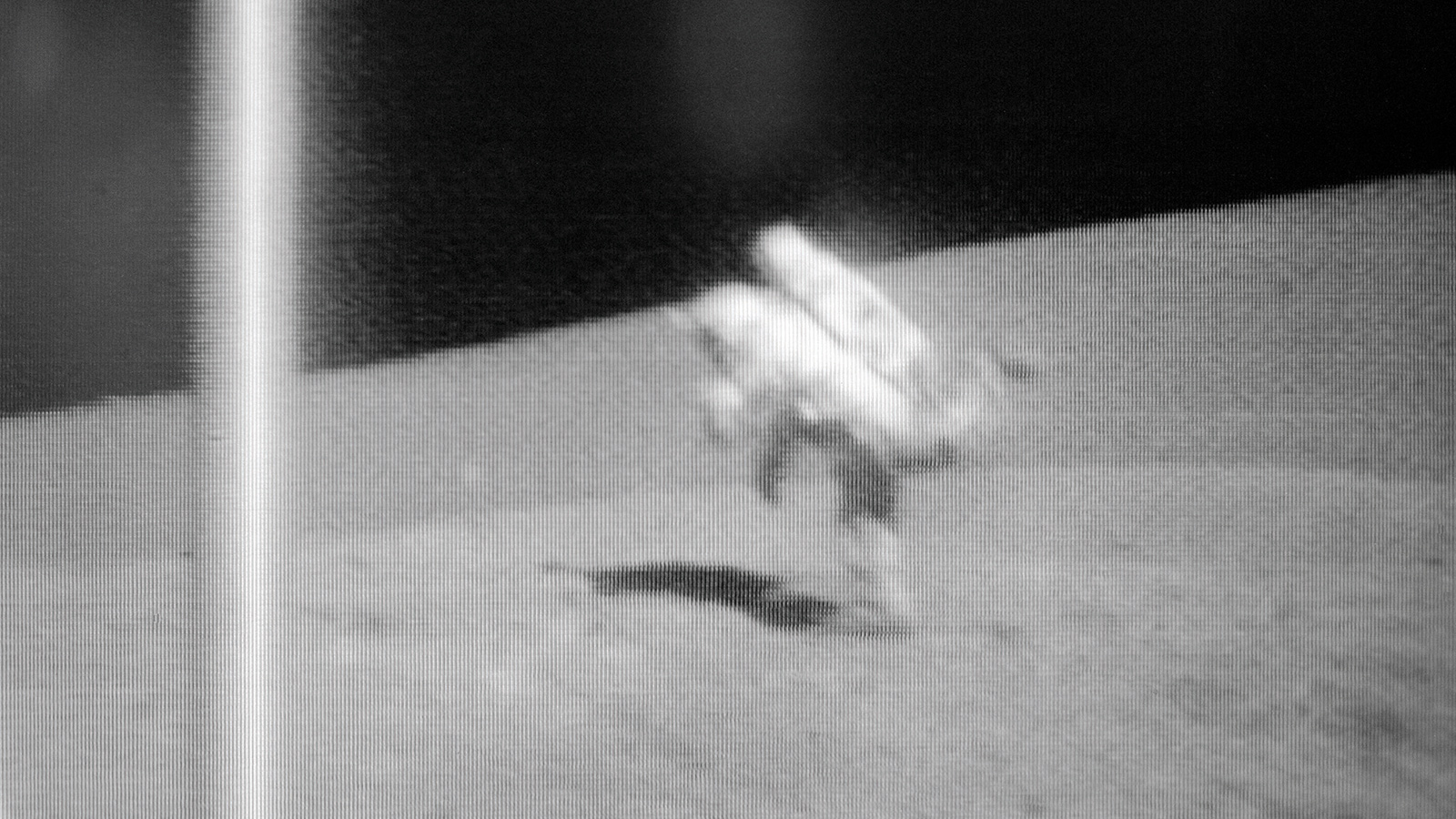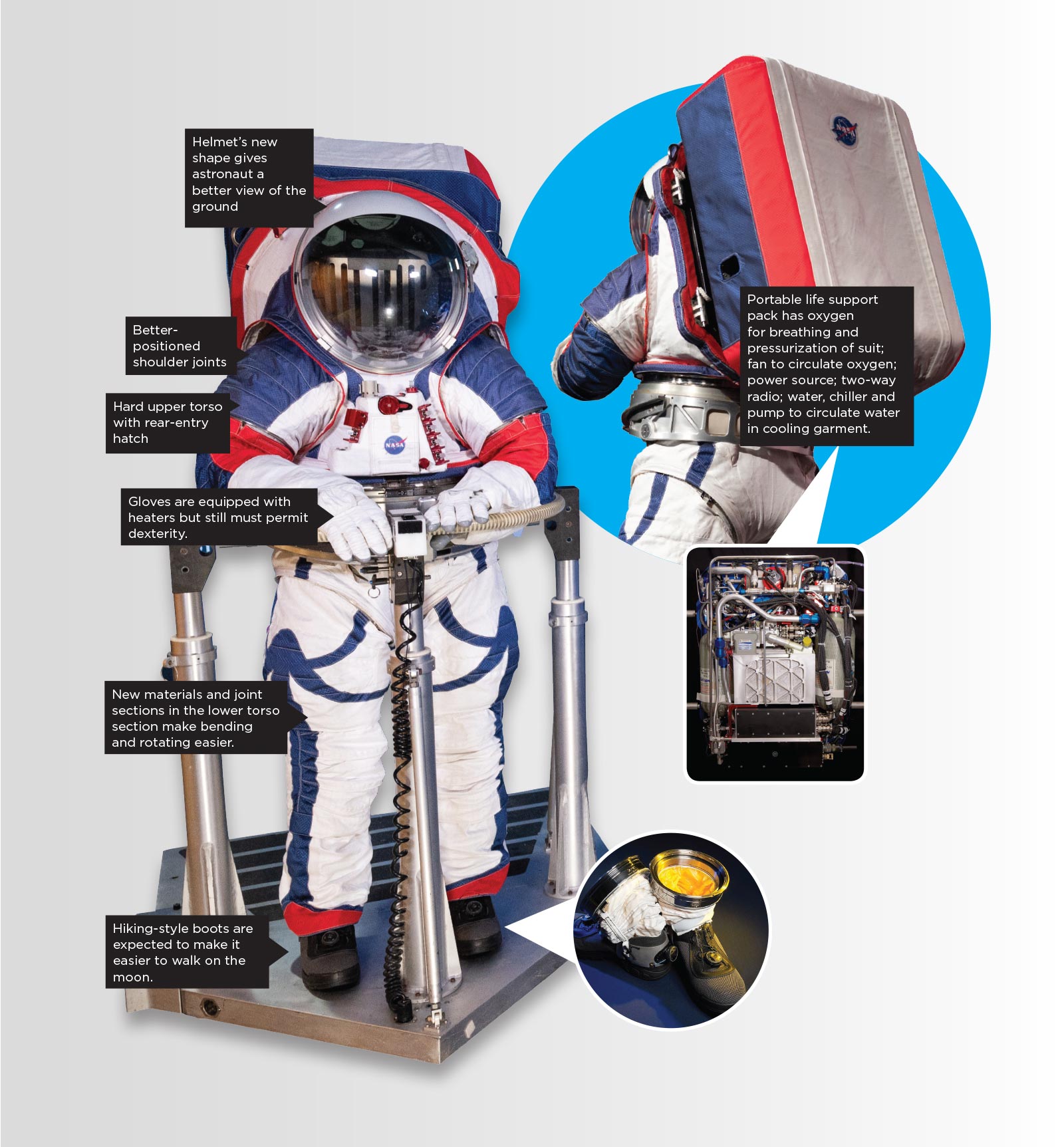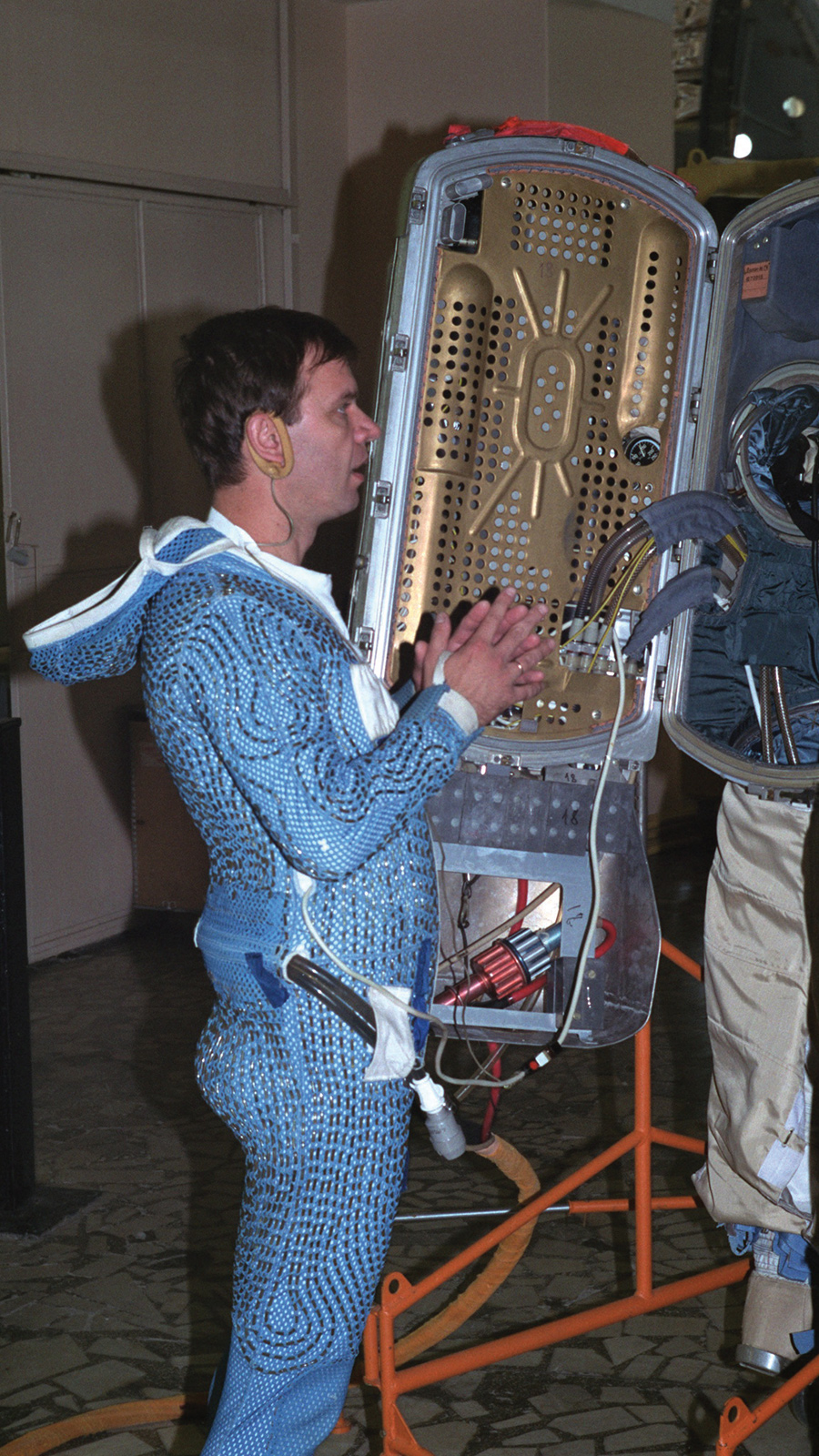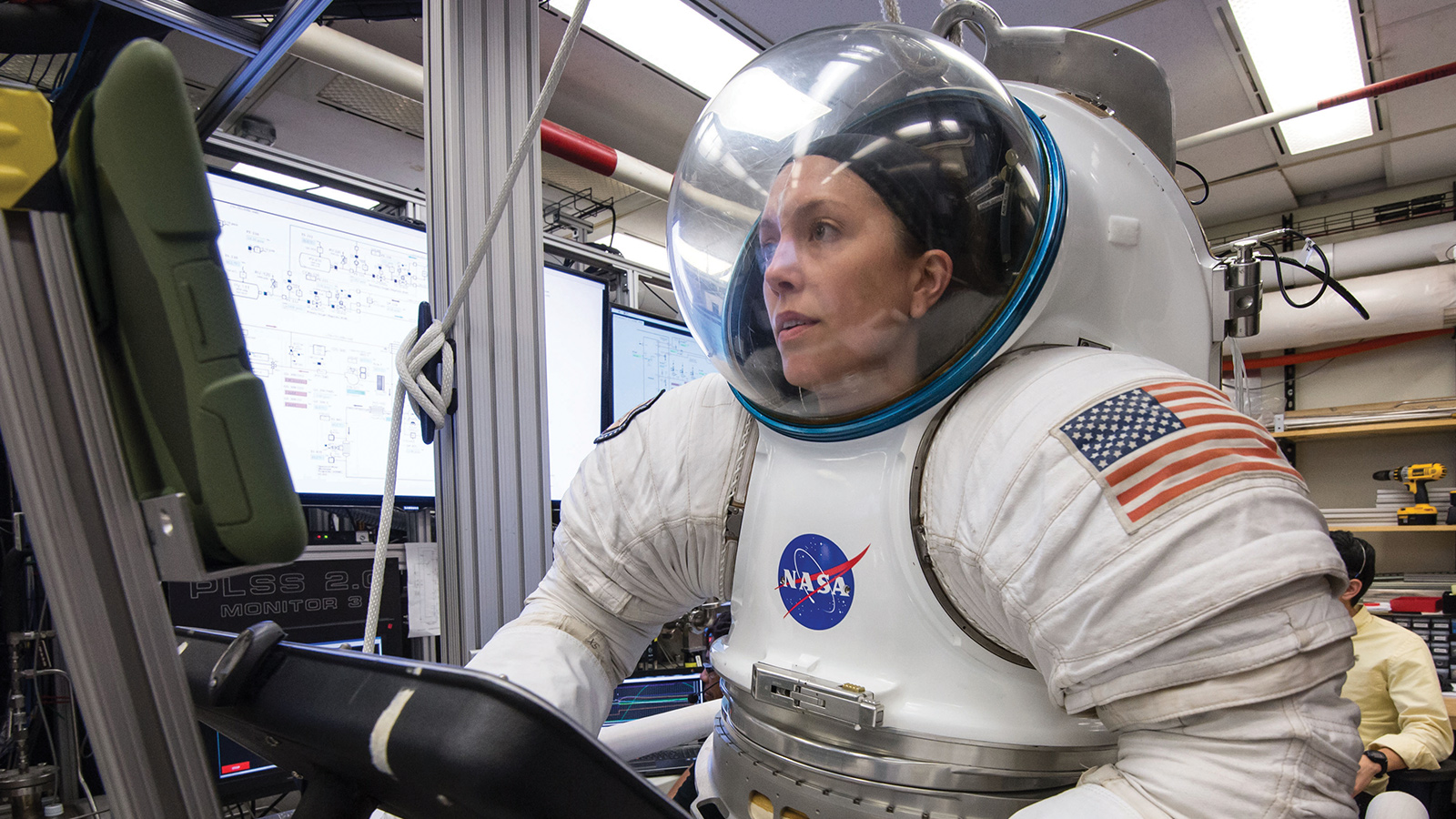Stay Up to Date
Submit your email address to receive the latest industry and Aerospace America news.
The current International Space Station spacesuit, designed 40 years ago for extravehicular activities from space shuttle orbiters, would frustrate any moonwalker. Veteran spacewalker Tom Jones looks at how NASA will build a moon suit in time for the planned 2024 lunar return.
Neil Armstrong’s and Buzz Aldrin’s A7L spacesuits enabled the first moon walk, but exhibited significant shortcomings in flexibility, internal comfort, glove utility and life support capacity. Armstrong, in a technical debriefing after landing, was specific: “We should clear that suit so that you could go down to your knees, and we should work more on being able to do things on the surface with your hands,” he said.
If NASA’s Artemis program succeeds in returning astronauts to the moon, those explorers will need a new and capable suit design, one benefiting from Apollo and shuttle experience and incorporating the fruits of over two decades of NASA technology investment. Work on the lunar suit is accelerating at NASA’s Johnson Space Center in Houston.
This is great news. The current Extravehicular Mobility Unit, or EMU, was designed in the late 1970s for spacewalking outside the space shuttle orbiters.
Having worn an EMU during three spacewalks on the International Space Station, I can attest that the design is rugged, but it’s stiff and affords limited mobility. An EMU with a 73-kilogram (160-pound) astronaut inside weighs 145 kilograms. This mass is still present in space, and an astronaut must get it all moving and then stop it at a worksite. Beyond that, the suit’s legs were not designed for walking; at ISS, they serve merely as anchors in foot restraints. And the exterior fabric and life support systems were designed to function in the vacuum of empty space, not on a dusty moon or planetary surface.
The xEMU
So, NASA’s goal is “to develop an exploration-class spacesuit,” says Liana Rodriggs, the xEMU project manager at Johnson, by email. Variants of the design will enable Artemis astronauts to walk on the moon or work outside the planned lunar Gateway or today’s ISS. The agency plans to build three xEMU suits in-house at Johnson in time for testing on ISS and the 2024 lunar return.
The xEMU will capitalize on lessons from Apollo, decades of EMU experience on shuttle and at ISS, and lab and field tests of surface suit concepts dating back to at least 1989. The new design will remedy the ISS EMU’s deficiencies, incorporate mobility and life support advances, and be maintainable in orbit or at a lunar outpost.
The xEMU Phase I design will be for ISS or the lunar Gateway. Its upper torso will be a machined aluminum shell with a rear-entry hatch, like the rear entry feature of Russia’s Orlan EVA suit. Rear entry reduces the contortions necessary to don the suit, and the shoulder bearings are canted forward, lining up more naturally with an astronaut’s shoulders and upper arms. By contrast, today’s EMU must be donned by wriggling up from below, forcing the shoulder bearings to face more to the left and right, an orientation that contributed to long-term shoulder injuries among astronauts.
The Phase I xEMU will introduce a redesigned helmet with better downward visibility and a built-in mic and speaker system, eliminating the sweaty “Snoopy cap” that always seemed to slip down over my eyes. For missions far from Earth, the helmet may also incorporate projected infographics displaying life support parameters, procedures and reference material.
Amy Ross, the xEMU pressure garment subsystem lead at Johnson, tells me that the Phase I suit will get its first test outside the ISS in mid-2023. This test suit will be a hybrid, incorporating the new torso and life support system, but with gloves, legs and boots transferred from today’s EMUs. An astronaut in the xEMU will put the new suit through its paces while shepherded by a crewmate in the standard ISS EMU.
Stayin’ alive in deep space
Astronauts can’t survive and work effectively outside their spacecraft without a portable life support system to supply oxygen, battery power, cooling and CO2 removal from the suit’s atmosphere. Today’s PLSS backpack traps CO2 by circulating air through a canister of silver oxide particles. The canister can remove CO2 for up to eight hours. Back inside ISS, a heating chamber forces the reusable cartridges to give up their CO2, which is vented overboard. By contrast, the new PLSS will have a constantly renewable absorber consisting of a pair of chemical beds containing amine, organic compounds containing nitrogen. “One [bed] is always absorbing [CO2] and one is always desorbing to vacuum,” explains Ross. The beds swap functions periodically so that one will “continue to remove CO2 for the duration of the EVA,” eliminating the current EMU’s limit on EVA endurance.
Then there is the matter of cooling. Today’s EMU PLSS pumps cooling water through an inner garment laced with thin tubes. The water circulating around the torso and limbs absorbs heat generated by an astronaut’s work and cellular metabolism. This warmed water circulates through a sublimator unit in the backpack, where a separate water supply trickles into a porous metal block, where it cools and freezes as it sublimes directly into vapor in the space vacuum. This sublimation-formed ice bed chills the warmed suit water, which then recirculates to cool the astronaut.
However, this sublimator’s tiny pores and air-water separator are sensitive to water impurities; clogging can cause loss of cooling and even force water into the helmet.
The xEMU PLSS resolves this contamination susceptibility and avoids the need for a separate water supply by letting some of the water from the cooling garment evaporate directly into space through a permeable membrane. The device is called a spacesuit water membrane evaporator, or SWME, and is pronounced “swimmy.” The SWME “has already gone hundreds of hours in testing and is not nearly as sensitive to water quality,” Ross says. If her team can achieve the required manufacturing quality, the SWME should be a reliable, rugged cooler that works at vacuum and in Mars’ thin atmosphere.
To the moon
The Phase II surface suit is being developed in parallel with the Phase I xEMU. The NASA-industry team plans to adapt the Phase I design for the surface by adding a lower-body pressure garment, known as the lower-torso assembly, that will provide much greater surface mobility than the Apollo design. “We’ve been working on prototype suits since at least 1989 that give us a good idea about how to put those components together for the lower [suit]. We’ll be building on what we have — probably a two-bearing hip with soft goods [fabric] between the two bearings that allows you to walk the way you want to,” Ross says.
Moonwalkers should be able to walk, lope, skip, crouch, bend over and even kneel on the lunar surface. But Ross says that “putting a shell on a human and asking him to move like a human is a big challenge. We’re probably never going to be able to do backward handsprings.”
In addition to lunar legs, a surface xEMU will need an environmental protection garment, an external layer to protect the wearer from thermal extremes, micrometeoroids and dust intrusion. The Apollo suits were quickly degraded by jagged, microscopic dust grains infiltrating their joint bearings and mechanisms.
The current EMU’s white outer protection layer consists of Ortho-Fabric, a blend of Gore-Tex, Kevlar and Nomex. Ross says Ortho-Fabric is a woven material full of holes — not what you want for dust repulsion. Her team is looking to textured, bio-inspired coatings, like the tiny, self-cleaning hairs on gecko feet, to help repel dust.
The ISS EMU’s Phase VI gloves, like those I wore at the station, are not perfect, but they have enough dexterity for early lunar missions. Transferring them to the new suits means adding an extra outer layer for lunar dirty work. As for the boots, years of field testing on prototype suits have given the team a leg up on their design.
Tight schedule
In 2023, the xEMU project must deliver three flight units: two for the first Artemis lunar landing in 2024 and one to demonstrate the new suit on the ISS. Rodriggs, the project manager, says the 2023 ISS tests could “extend up to a year in order to perform a series of EVAs to prove out the xEMU’s capabilities.” She says the two xEMU suits for working on the moon will be complete by early 2023, in time to be launched to the Gateway to await the first landing crew.
To meet that schedule, Rodriggs leads approximately 45 civil servants and 170 contractors, a team that will continue to grow next year to incorporate the new suit capabilities and meet the Artemis deadline. Already, dozens of companies spread across the country are developing xEMU components. After tests in orbit and the initial lunar return mission, NASA plans to seek an industry partner, or partners, from this team to build a fleet of suits and maintain them at ISS and on future lunar and Mars expeditions.
NASA has tried for a couple of decades to field a new spacesuit, efforts that have stalled for lack of funding. Money is still the critical factor, as it is for Artemis as a whole. Today, though, says Ross, “our financial situation has changed. The budget box is opening up, [and] we have resources enough to give us confidence in meeting the schedule. NASA is serious about doing this — and doing this in time.”
During my August visit to Johnson’s advanced spacesuit laboratory, I got a close-up look at prototypes of the xEMU’s sleek, aluminum hard upper torso and rear-entry hatch, redesigned shoulder bearings and joints, and wrap-around bubble helmet. Rodriggs, Ross and their xEMU team will develop flight hardware from these, provided they receive healthy Artemis funding from Congress to capitalize on decades of research. “We did the technology development work in a meaningful way,” Ross says, and now the team is “ready to move toward flight with some confidence. We have a lot of support at all layers of NASA management. We can move on this.”
About Tom Jones
Tom flew on four space shuttle missions, including his last flight, STS-98, in which he led three spacewalks to install the American Destiny laboratory on the International Space Station. Tom is a senior research scientist at the Florida Institute for Human and Machine Cognition.
Related Posts
Stay Up to Date
Submit your email address to receive the latest industry and Aerospace America news.







